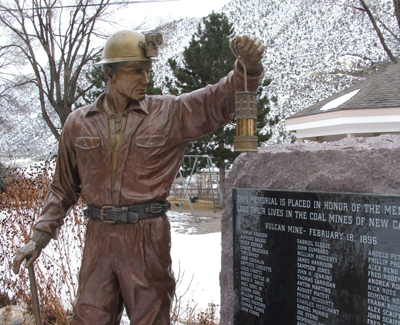This week we use our digitized historical documents to travel back to 1896 and one of the state’s worst mining disasters. On the morning of February 18 of that year, an explosion at the Vulcan coal mine near New Castle, Garfield County caused the death of forty-nine miners. Among those killed were the mine’s foreman, assistant foreman, and fire boss. Two fourteen-year-old boys were also among the victims. About half of the fatalities were Italian immigrants.
The mine was owned by the Atchison, Topeka & Santa Fe Railroad to supply coal for the railway. Just ten days before, the mine had been inspected by David Griffiths, the State Inspector of Coal Mines, who pronounced it in fine condition. His report and justification can be accessed online from our library — information on the Vulcan explosion starts on page 47. “I did not visit all the working faces, but was satisfied from what I had seen that the local management was doing everything for the safety of life and property,” he wrote. He also noted that he had not received any complaints from miners about the condition of the mine. However, later investigation revealed that miners had issued complaints. Five days after the disaster, Governor Albert McIntire tasked the inspector with determining the cause of the explosion, particularly in light of his positive report of just days prior. The inspector’s “endeavors were fruitless,” however, and the cause of the explosion remained a mystery. He suggested that the accident may have been caused by a defective safety lamp igniting gas in the mine, or a miner’s carelessness in exposing a lamp to gas and flammable coal dust. Griffiths finally concluded, however, that the accident was caused by explosives used to open a blocked entryway, mixing with dust to form a flame that elongated and then exploded when it reached an area with an accumulation of gas. However, a team of representatives of the mine had varying opinions on this potential cause and no consensus was reached. “There are some peculiarities in connection with this explosion,” Griffiths admitted.
The forty-nine deaths made the Vulcan disaster one of the deadliest mine disasters in Colorado history. It was such as large explosion that “the town of New Castle was shaken as if by an earthquake,” noted the Colorado Springs Gazette. The explosion caused so much debris that the bodies could not be recovered until March 15, four weeks later. The 1896 disaster would not be the Vulcan’s last. In December 1913, another explosion, also thought to be caused by gas and dust conditions in the mine, caused the deaths of thirty-seven men. The report of the 1913 explosion can be found starting on page 46 of the 1913 coal mine inspector’s report, also available from our library. Following the second disaster the mine reopened on a smaller scale, later being operated by the Rocky Mountain Fuel Company and renamed the Garfield-Vulcan. In 1919 a fatal explosion again rocked the mine, this time causing three deaths. Following these disasters the mine ceased to operate, but coal seams still burn in the mountains around New Castle to this day. In 2004, the town erected a memorial on the town’s Main Street commemorating the victims of the mine explosions.

- How to Spot the Differences Between Eagles and Hawks - August 16, 2021
- How Transportation Projects Help Tell the Story of Colorado’s Past - August 9, 2021
- Time Machine Tuesday: The Night the Castlewood Canyon Dam Gave Way - August 3, 2021